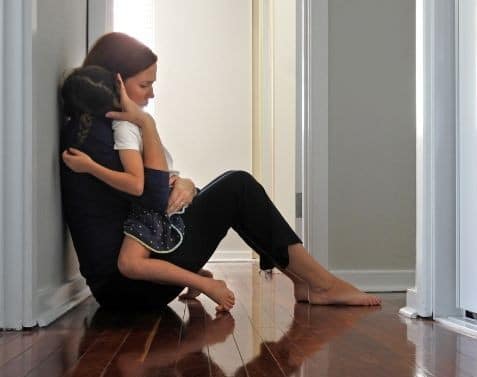How Is A Tantrum A Bid For Connection?
The man at my parenting talk is exasperated by his two-year-old son’s behavior.
“First, he wants a glass of milk,” he tells me. “I pour the glass and hand it to him, and he gets upset and says he doesn’t want it. So I say, ‘Okay, then, I’ll drink the milk.’ I’m trying to show him I’m flexible. But he fusses and says, ‘No, don’t drink it, I want it!’ I offer it to him again, and he swats it away! What in the world is going on?”
He adds that these episodes are increasing. What could end this cycle of contradictory wants that is spiraling out of control? What is he doing wrong? What does his son need?
Signs A Tantrum Is Coming
This child was teetering on the edge of a tantrum, a very uncomfortable place for him and for his parents. Every child I know has moments when nothing he asks for actually helps, and when every attempt to fill his needs seems to make things worse. I offered the father a fresh perspective on tantrums that makes parenting young children much simpler, if not easier. The headline is that you can safely and serenely allow your child to have the tantrum he is heading toward. That tantrum is necessary. It’s healthy, and it’s healing. All you need to add is your warm attention. The tantrum you permit him to have clears a jam in his mental and emotional system so he can think well again.
Let’s look at this approach in more general terms. Most of us evaluate our parenting in a very straightforward way. When our children are happy, cooperative, loving, and polite, we take pride in them and in ourselves as parents. When our children are unhappy or unreasonable, we figure that something has gone wrong, and we tend to blame ourselves or them. In short, we’ve been trained to think of children’s upsets as “bad.”
When an upset arises, we want to put an end to it as quickly as possible. Some parents try distraction or reasoning; others use intimidation and force. Whatever our methods, conventional wisdom has it that it’s our job to end the upset. We require our children to tuck their upsets away and be “good” again. We don’t want them to grow up to be uncivilized, and we don’t want to feel or look like “bad” parents with “bad” children.
But what if, contrary to what we’ve grown up believing, tantrums and other expressions of feelings are actually useful? What if a tantrum is like an emotional sneeze — a natural reaction meant to clear out foreign material? Perhaps the usual struggle of parent versus child at emotional moments doesn’t have to take place. Perhaps we can throw away the mental chalkboard on which every meltdown is a mark against our children or ourselves.
A New Way To View Tantrums
There are four pivotal perceptions that can help us see tantrums in a new light
- Children enjoy being easy-going, loving, cooperative, and eager to learn. Children are built to take in lots of good experiences, and to operate with joy and enthusiasm.
- Children’s good nature can be obscured by bad feelings. When they are sad, frightened, bored, frustrated, or embarrassed, or when they feel alone or unappreciated, their good nature becomes clouded with bad feelings. This emotional tension pulls their behavior off track, away from trust, cooperation, and enthusiasm. When they are loaded with bad feelings, children literally can’t think.
- Hurt feelings confine a child to unloving, fearful, or irrational behavior. A child will openly present this behavior in order to signal for help. The child who wanted milk, then didn’t, then did, then didn’t, was signaling as plainly as he could that his ability to think was compromised. He was asking for help with a knot of unruly feelings.
- A child who is upset or inflexible can recover their ability to reason and to be pleased. To do this, he needs a supportive adult close by, while he works through his upset.
Feelings Spilled are Feelings Resolved
 A child cries, throws a tantrum, or sometimes trembles and struggles, to expose and offload her bad feelings. During upset, a child does their best to dig herself out of an irrational state. My suggestion to the father whose son was on the verge of a tantrum may seem counterintuitive, but it works. He could stop trying to solve the unsolvable glass of milk problem, move close to his son, and pay full attention to whatever happens next.
A child cries, throws a tantrum, or sometimes trembles and struggles, to expose and offload her bad feelings. During upset, a child does their best to dig herself out of an irrational state. My suggestion to the father whose son was on the verge of a tantrum may seem counterintuitive, but it works. He could stop trying to solve the unsolvable glass of milk problem, move close to his son, and pay full attention to whatever happens next.
His son will lead the way.
Usually, when a child feels that the parent has slowed down and is interested in her rather than in solving a practical problem, the feelings rise up and spill out, just the way they’re meant to. Feelings spilled are feelings resolved. Feelings spilled are not a child’s permanent assessment of the quality of our parenting. The father could listen with care to the tantrum, keeping his son safe throughout, trusting that he will soon make his way back to a reasonable state of mind.
It takes courage to listen to your first tantrum from beginning to end. It’s usually an emotional wringer for the parent who tries it. Like opening your eyes underwater for the first time, you may worry that you are doing damage. But the results are almost always thoroughly convincing. Your child feels heard. She sees that you’ve stayed with her through the worst of how she felt. Her mind clears, and life satisfies her again.
As parents gain experience staying close through their children’s emotional storms, they find that the trip no longer feels quite so risky or grueling. Their child’s upsets, which once seemed to point to a serious failure, now simply signal the need for a good cry, or a good tantrum. The child’s system is on the fritz, no blame or shame involved, and the remedy is wet and wild, but simple.
Tantrums Help The Learning Process
Tantrums arise as children’s expectations become more ambitious and more detailed. Their ideas of what they want to do are grand, yet their abilities grow only through the messy process of trial and error.
You know the scenario. Your child can’t make things go her way and, to her credit, won’t give up trying. Eventually, she runs out of new approaches. She wants to succeed, but can’t figure out how. Your well-meaning suggestions don’t help, because in this emotional state she can’t make use of any guidance; she must either fall apart or abandon the effort. Distracting her from the effort sometimes heads off the tantrum in the short run but doesn’t help in the long run. When she returns to that learning task or that expectation (or when, five minutes later, she finds another pretext to ignite her feelings), frustration will flare again, because until a tantrum dissolves it, the frustration stays pocketed inside her, agitating to be released. Feelings of frustration are an everyday glitch in the learning process, an unavoidable result of the clash between what children expect and what turns out to be possible.
As director of an infant-toddler day care center, I saw tantrums happen for each and every child. We built very close relationships with the children. We saw all of them go through periods of time when they could meet challenges without losing their equilibrium. Inevitably, however, a time came when it seemed that any small disappointment would trigger a tantrum. We saw that children who were about to walk, children who were about to talk, and children who were moving toward closer relationships with each other were likely to have regular tantrums. Actually, we usually noticed the tantrums first, and observed carefully to figure out the leap the child was working hard to make. We adults are trained to be so dependent on verbal language that we tend to be on the slow side in reading the language of children’s behavior fluently.
 I remember Janna, who was beginning to say her first words. Suddenly she would scream, throw herself down on the floor, and press her cheek into the soft carpet. She crawled, crying and plowing her cheek across the floor, for five or ten minutes. I would stay close and be the bumper that kept her from hitting her head on the furniture as she worked her way noisily around the room. I would murmur that I saw how hard it was, that she was doing a good job of showing me how she felt, and I stayed ready to welcome her into my arms when her explosion was completed. Finally, she would sit peacefully on my lap, let me meet her gaze and stroke her sweaty head, and then she was ready to play.
I remember Janna, who was beginning to say her first words. Suddenly she would scream, throw herself down on the floor, and press her cheek into the soft carpet. She crawled, crying and plowing her cheek across the floor, for five or ten minutes. I would stay close and be the bumper that kept her from hitting her head on the furniture as she worked her way noisily around the room. I would murmur that I saw how hard it was, that she was doing a good job of showing me how she felt, and I stayed ready to welcome her into my arms when her explosion was completed. Finally, she would sit peacefully on my lap, let me meet her gaze and stroke her sweaty head, and then she was ready to play.
After a few weeks of many meltdowns, more words were at her disposal, and her tantrums subsided.
When he was two, my younger son had a set of tantrums that are etched in my mind. He was intently hitting a balloon toward the ceiling over and over again. I thought nothing of it until he suddenly collapsed in an active frenzy. I came closer and gave him my attention, not knowing what had happened to set him off, but knowing that once he had begun, he needed to finish, and needed me there. After five minutes or so, his mind cleared and he got up, we connected, and he went back to hitting the balloon high again. One hit, and he threw himself back down, kicking and thrashing. At that point, I realized what was going on: he thought he ought to be able to make the balloon hit the ceiling, and he couldn’t! His expectation stretched beyond his ability. After another, shorter blast of frustrated energy, he finished, connected with me, and picked up the balloon to play with it again. He was finally happy with what he could do with the balloon. These “learning leap” and “expectation adjustment” tantrums are vital, integral parts of the learning process. When your child’s learning curve is high, when she’s hopeful and active, tantrums may be frequent; she is regaining her ability to try again when she has failed and adjusting her expectations of herself, of what she’s permitted to do, and of you. She is learning by experience and blasting away the negative feelings that sometimes come with trying so hard and meeting disappointment. Tantrums are the “sneeze” that ejects the foreign material of frustration from your child’s mind and body, so she can be proud of her abilities and her circumstances again.
In Part Two of Patty's Ultimate Guide to Tantrums where you can find out how to get comfortable allowing tantrums, how upsets can help kids work on deep-down core issues and how you can respond to extended crying sessions to build trust.
Read part two of Patty's Tantrums series here.
This article first appeared on mothering.com
From the Hand in Hand Toolbox:
- Discover how children's emotions are linked to their behaviors. Download this free guide

